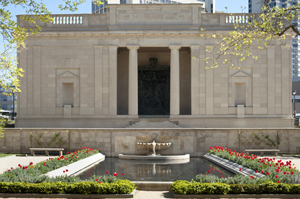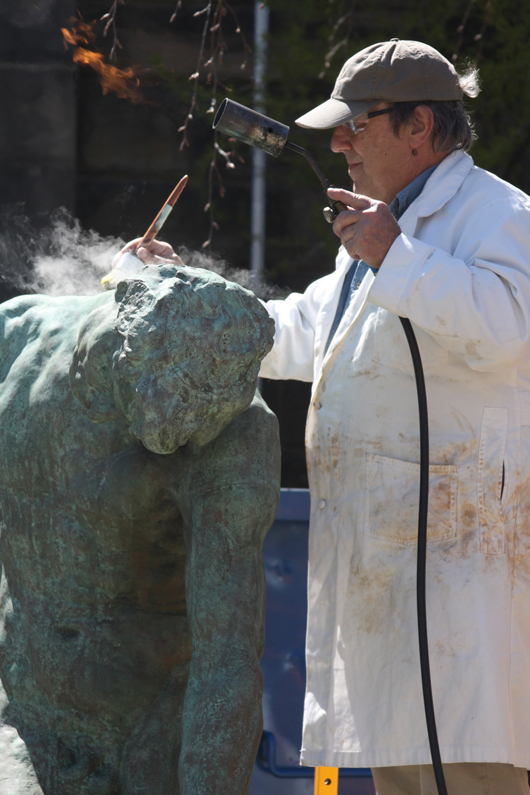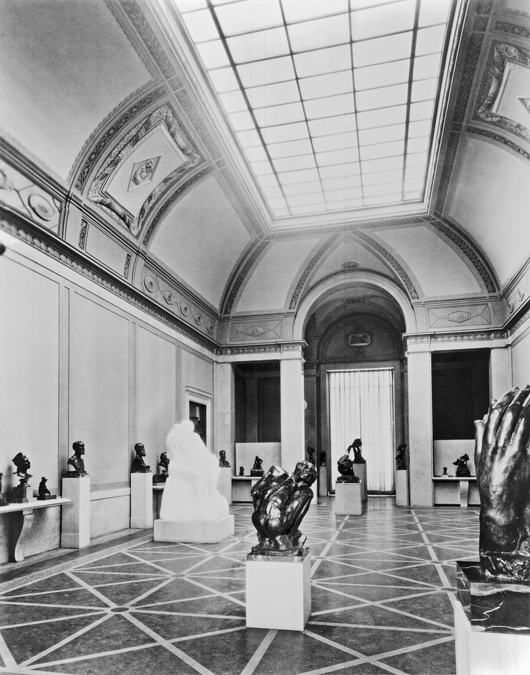
PHILADELPHIA – On July 13 Philadelphia’s Rodin Museum will reopen to the public, its collection reinstalled and reinterpreted and its buildings and gardens restored to the condition that visitors would have experienced when the museum first opened to the public in 1929.
This comprehensive renovation, accomplished over the past three years, included the restoration of the gardens designed by Jacques Gréber, the restoration of the Meudon Gate and exterior of the Rodin Museum, both designed by the great Philadelphia architect Paul Cret, and the restoration of the interior and reinstallation of the collection, which represents one of the most important holdings of Rodin’s work anywhere.
This summer, visitors will once again see several of Auguste Rodin’s greatest works, including The Burghers of Calais, in the garden, in niches on the museum’s façade, and in the arches of the Meudon Gate for the first time in many decades, as Cret initially installed them.
In the galleries of the museum, they will encounter an entirely new presentation of the collection. The reinstallation includes 90 works in a variety of materials—bronze, marble, terracotta, and plaster—that survey the genesis and development of Rodin’s monumental The Gates of Hell, a project inspired by Dante’s Inferno that consumed the artist for nearly four decades, from 1880 until his death in 1917. Visitors will be able to learn more about Rodin’s work through new interpretive tools, including a new mobile app, and new public programs such as family activities and performances. The Rodin Museum will be open to the public from 10 a.m. until 5 p.m. Wednesday through Monday. It will be closed on Tuesdays.
“The opening of the Rodin Museum in November 1929 represented a high point in this city’s efforts to create the Benjamin Franklin Parkway as a great civic space,” said Timothy Rub, the George D. Widener director of the Philadelphia Museum of Art. “As this important cultural district reaches another milestone this summer, with the opening of the new home for the Barnes Foundation just across 22nd Street, it was both fitting and necessary for us to focus attention on the Rodin Museum. This is, fundamentally, an act of stewardship, restoring one of Philadelphia’s loveliest buildings, which is notable for the purity of its design and the restrained elegance of its ornament, and reinstalling and reinterpreting one of the finest collections of Rodin to be found anywhere in the world.”
Returning the Rodin Museum to its original design has required a comprehensive cleaning that embraced the exterior stonework as well as the building’s tall windows and high dramatic skylight that extends across the vaulted main gallery and now generously bathes the space below in far more daylight. Within the refurbished galleries, the inaugural installation of the collection will be dedicated to The Gates of Hell as a tribute to the artist’s epic vision and to the passion of the museum’s founder, Philadelphia entrepreneur and collector Jules Mastbaum (1872-1926). Mastbaum paid for the first two bronze casts of Rodin’s Gates, the earliest of which has stood in the Museum’s portico since 1929. In 1880 Rodin received the commission to create The Gates of Hell. It became the defining project of Rodin’s career, occupying him the last 37 years of his life. The artist’s most famous work, the brooding The Thinker, which faces the Benjamin Franklin Parkway before the museum’s entry gate, was also conceived as part of the project and was later enlarged and cast in bronze as an independent work. Mastbaum ordered the casts of the Gates from Rodin’s estate in 1925, eight years after the artist’s death, and presented the second cast to the Musée Rodin in Paris.
The galleries will also feature other major public sculptures, including maquettes for the monument honoring the celebrated French author of La Comédie Humaine, Honoré de Balzac that became recognized as a pioneering work of modernism. Additional masterpieces on view will include Rodin’s plaster of Eternal Springtime, an evocation of human love, and the Apotheosis of Victor Hugo. A marble, The Kiss, has also been returned to its original position in the museum. A replica of Rodin’s original, it was carved for the museum in 1929 by the sculptor Henri Gréber, father of the Parkway’s designer, Jacques Gréber, with the authorization of Rodin’s estate. A popular favorite in Philadelphia until it was removed in 1967, its return to the main gallery reflects its importance as a celebrated element of the Rodin Museum’s original scheme.
Outside the museum, eight works will now be displayed in the garden, most of which have not been seen there for decades. While both The Thinker and The Gates of Hell have stood in their same locations since 1929, advances in conservation undertaken by the Philadelphia Museum of Art have permitted the return of Adam and The Shade to their original places within the arches of the Meudon Gate for the first time since 1963. The Age of Bronze and Eve have also returned to the niches they originally occupied on the museum building, overlooking the reflecting pool. To the east of the building, The Burghers of Calais once again occupies the semicircular garden where it stood until 1955, when it moved to the west entrance of the Philadelphia Museum of Art. In 1967, The Burghers of Calais was moved to the interior of the Rodin Museum, becoming its centerpiece. On the building’s west side, a space vacant of sculpture for most of the museum’s history now contains a version of the monumental Three Shades, on loan from the Iris and B. Gerald Cantor Foundation.
“When we began to consider how to reinstall the galleries, I wanted the sculptures that were placed by Cret in key positions on the exterior of the museum and in the garden to be once again outdoors,” notes Rub. “The Burghers is too large a work to fit comfortably within the galleries, and after returning this heroic work to its commanding place in the east garden, it seemed only fair to return The Kiss to its place in the main gallery, where it could finally delight the public once again.”
The interior and exterior renovations and reinstallation of the collection will allow visitors to experience Rodin’s sculpture in a new way. “Visitors will be able to explore the most significant aspects of Rodin’s life and career, his relationship to the art of his times, and the salient features of his artistic style, all of which will help demonstrate why his work was so revolutionary and why he is considered a seminal figure in the history of modern art,” notes Joseph Rishel, senior curator of the John G. Johnson Collection and the Rodin Museum.
Public tours led by museum guides will take place daily at 1:30 p.m. A full range of public programs will be produced including activities for families with children and interactive art-creating programs.
For additional information, contact the Marketing and Communications Department of the Philadelphia Museum of Art at 215-684-7860. The Philadelphia Museum of Art is located on the Benjamin Franklin Parkway at 26th Street. For general information, call 215-763-8100, or visit the museum’s website at www.philamuseum.org.
ADDITIONAL IMAGES OF NOTE







